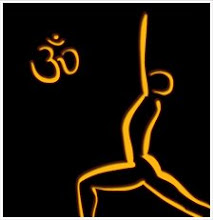Uddiyana bandha and nauli are used to massage internal organs in the abdominal area and to stimulate the function of the alimentary system. They improve the overall digestive health and are beneficial for regulating bowel movements and stimulating digestion of food, absorption of nutrients and excretion. It is important to notice, however, that women who are pregnant or wishing to conceive should not be practicing uddiyana bandha or nauli. Always practice these on an empty stomach.
Uddiyana Bandha
"Pulling the abdomen back and making the navel rise is uddiyana bandha. It is the lion which conquers the egale, death."(Hatha Yoga Pradipika)
Uddiyana bandha in this context is not the same as holding uddiyana bandha during asana practice. It is a practice which involves the sucking in and lifting up of the abdomen and stomach. It can be done while standing up, sitting or lying down. The suction massages the abdominal organs and stimulates circulation in this area of the body. Regular practice of uddiyana bandha brings alleviation to many digestive disorders, such as constipation and indigestion. It is also preparation for nauli which cannot be practiced without a strong uddiyana bandha.

How to perform uddiyana bandha:
Start off by lying down on the floor, legs straight or knees bent. Exhale all the air out of the lungs. Then take a false inhale, expanding the chest but without taking any air in and pull the stomach in and up to create a hollow space in the abdomen. Hold for a few seconds, then relax the abdomen and slowly inhale. This is one round. Rest for few more moments before doing another round. Start off with three rounds, and slowly build up to do ten rounds.
To do uddiyana bandha standing, stand with the feet just over hip distance apart. Slightly bend the knees and plant the hands on the thighs just above the knees, thumbs facing inwards and rest of the fingers facing outwards. Keep the back straight and the neck long. Fully exhale, then lower the chin down to the chest and raise the shoulders slightly. Take a false inhale as above and lift the stomach up. Hold, relax, inhale and rest for a while before another round.
Nauli
“Nauli is foremost of hatha yoga practices. It kindles the digestive fire, removing indigestion, sluggish digestion, and all disorders of the doshas, and brings about happiness."(Hatha Yoga Pradipika)

Nauli is an advanced practice during which the rectus abdomini muscles are contracted and isolated. They are the two long muscles that run across the abdomen from right underneath the ribcage to the pubic bone. The first stage of nauli, after mastery of uddiyana bandha, is to pull the muscles together and push them out while the rest of the abdominanl area remains sucked in as in uddiyana bandha. This is called madhyama nauli. The second stage is the rotating of the rectus abdomini muscles, either from right to left, which is called vama nauli, or left to right which is dakshina nauli.
Nauli is good for the toning of the entire abdominal area. Its benefits include, as listed in Hatha Yoga Pradipika alleviation of “(…) constipation, nervous diarrhea, acidity, flatulence, depression, hormonal imbalances, sexual and urinary disorders, laziness, dullness, lack of energy and emotional disturbances”. It is especially beneficial for regulating and stimulating excretion and can be done as a daily practice for these purposes.
How to perform nauli:
Start off by practicing madhyama nauli. Perform uddiyana bandha from standing up as described above. Contract the rectus abdomini muscles to create an arch that runs vertically along the abdomen. While the rest of the abdomen is sucked in, the long muscles are pushed out. Hold for as long as you are able to comfortably hold the breath, relax and slowly inhale. After a couple of rounds try pulsing the muscles, meaning taking turns to push them out and suck them back in. This has to be done during the same external breath retention. At first you may only be able to pulse a couple of times before needing to inhale. Over time it is possible to speed up the movement and perform several dozen pulses.

The stomach churning is an even more advanced practice. The muscles are pushed out as in madhyama nauli, and then rotated from one side to the other. At first, perform madhyama nauli, and then try push the muscles out on one side of the abdomen. To isolate the muscles on the left side, for instance, put pressure onto the left hand and thigh without leaning over. Relax first before doing the same to the right side. Alternate between the centre (madhyama nauli) and left and right sides. Once control of the rectus abdomini has been established, start rotating the stomach from one side to another in a continuous stream of movement. Do as many rotations as you can during one breath retention, relax and do the same number in the opposite direction.
At the beginning the hips will be moving along with abdomen. As nauli becomes more controlled, it is possible to decrease some of the movement by standing with the bottom against the wall, which prevents the hips from moving. Ultimately the nauli can be practiced while sitting down in padmasana.
To see a video demonstration please click here
Words by Meri Erkkilä
Sources:
Maharishi Swatmarama(with commentary by Swami Satyananda Saraswati and Swami Muktibodhananda), 1998: Hatha Yoga Pradipika; Yoga Publications Trust, Munger, Bihar, India
Swami Satyananda Saraswati, 1996: Asana Pranayama Mudra Bandha; Yoga Publications Trust, Munger, Bihar, India




